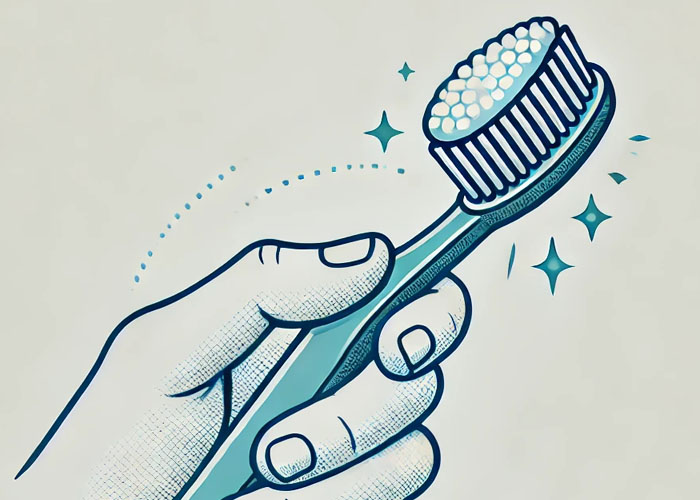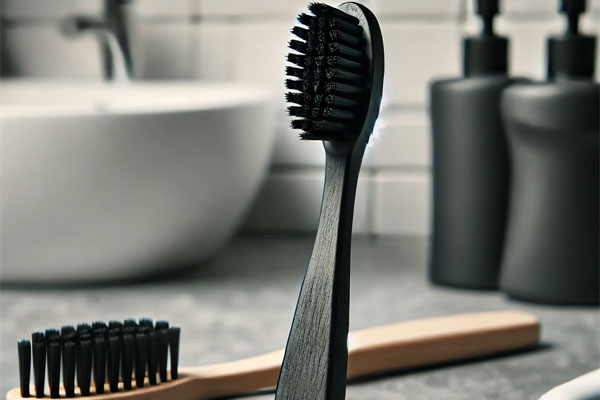As children’s dental health is concerned, parents are the super heroes who assist in creating healthy dental habits for the young ones. Read this guide that will give tips and recommendations on how to have a healthy and white teeth from baby stage to adolescence.
Infants (0-12 months): The Foundation of Good Oral Health
1. Dental Health for Babies – Starting from Day One
Infants also need to have their gums cleaned as well before teeth start to grow. Since children may not be capable of brushing their teeth regularly, gentle gum cleaning can assist in minimizing bacteria on the gum leads gum disease and acquaint the child with the act of brushing.
- Wipe Gums: As mentioned earlier, after feedings, you should use a wet clean cloth to clean your baby’s gums.
- Avoid Bedtime Bottles: Babies who are allowed to sleep with the bottle may be diagnosed of having tooth decay on their milk teeth. The best thing to be placed on the bottle is water.
- Teething Tips: For relief from pain when teeth start to grow (at 6 months), take a clean, teething ring to him to soothe the pain.
2. Building Comfort with a Routine
Children especially babies benefit from certain routine activities. Now it is the right time to establish a calming oral health care regime. After the teeth start to grow, use child toothbrush with soft bristles and only water without toothpaste to clean the teeth.

Toddlers (1-3 years): Creating Fun Oral Care Habits
1. Dental Care for Toddlers – Make It Fun!
Toddlers are active learners interested and at the same time, they may show a lot of defiance. Try to encourage brushing with music, brightly colored toothbrushes, positively reinforcing the child.
- Introduce Toothpaste: Children from age 2 should be allowed to brush but with only a pea-sized amount of fluoride toothpaste, they should be told not to swallow it.
- Brushing Together: Model brushing by holding your child’s hand and brushing your teeth at the same time and make him or her brush on a toy or teddy bear.
- Visit the Dentist Early: The first dental visit should take place within initial year of the baby or when the child has a first tooth. That way, it mitigates fear early on in their life before their official dental visit later on their life.
2. Handling Challenges
Children of this age are so eager to do things themselves, so let them hold the toothbrush or select a song while you perform the brushing. This age group may still be learning how to spit; so do practice this activity with plain water.
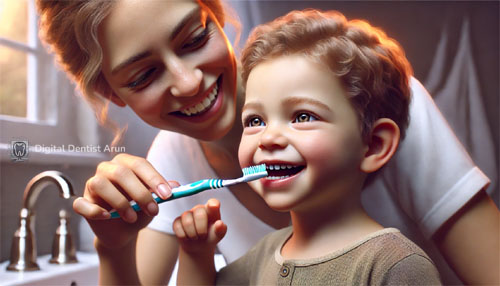
Preschoolers (4-5 years): Setting the Stage for Consistency
1. Preschool Dental Health – The Consistent Routine
Preschoolers are able to brush on their own with some supervision, this is a good age to demonstrate good practices to be adopted for the rest of the duration of their childhood.
- Regular Brushing: Brush at least twice per day with an ADA approved fluoride toothpaste.
- Flossing Fun: After getting the teeth cleaned up, one should start flossing the teeth. Explain to them how to do it; or using more friendly forms of flossers, which may be appropriate for children to use.
- Teach the Importance of a Healthy Diet: Talk to the child by explaining that sweet foods cause ‘sugar bugs’ to grow in teeth which causes pain. Provide good snack table to eat such cheese, apples and carrots that are good for the teeth.
2. The 2-Minute Brushing Rule
Kids should brush for two minutes, but explaining time to a kid which might be difficult to understand, especially at this age. You can use a timer or a favorite song to help in the counting.
3. Introducing Dental Visits as an Adventure
Children starting from infancy may be afraid to go to a dentist. Present the visit as a fun trip and discuss positive aspects of the procedure to which children refer as “tooth-checking.” Do not use such terms such as ‘pain’, ‘hurt’, in order to make the experience a positive one.
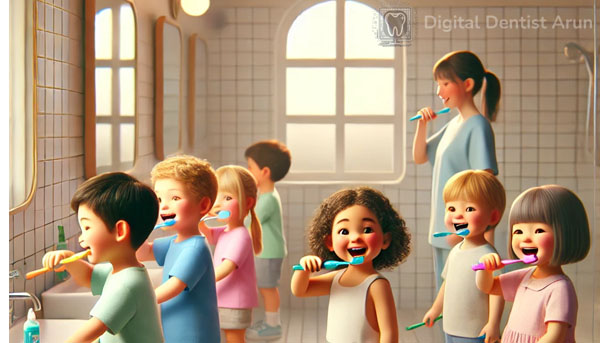
School-Age Children (6-12 years): Building Accountability
1. Dental Hygiene for Kids – Growing Responsibility
School age children can be more responsible for their teeth and their oral status with little supervision from you.
- Supervised Independence: Allow children to brush and floss alone but do not fail to monitor to see whether the teeth are cleaned properly.
- Emphasize the Importance of Flossing: Kids often overlook flossing. Establish a form of a rhyme or a song, which they can sing in order to be reminded of the aspect.
- Limit Sugary Drinks and Snacks: Promote drinking more water and less on soft or sports drinks, sweetened beverages. Describe how sugar works to damage a “super-strong” teeth.
2. Dealing with Orthodontic Concerns
During this age, your dentist may suggest an orthodontist examination if required. Talk to your child about why you need braces and tell him that it will make it easier to clean his teeth.
3. Encourage Regular Dental Checkups
Children should pay a visit to the dentist at least twice per year. You can tell them that those checkups are some form of “painting,” or “coating” that is done on their teeth tp prevent cavities. Few dental offices indulge their patients with toys or stickers after the visits, which makes it a good experience .
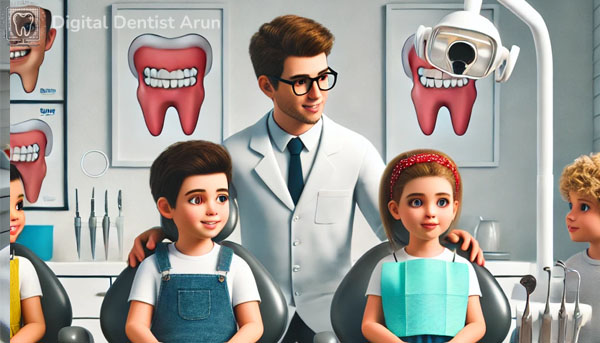
Teens (13-18 years): Independence and Reinforcement
1. Teen Dental Health – Making it Last a Lifetime
Teenagers have extremely tight schedules in most cases and this is because they do not find the time to attend to their teeth as they should. Remind responsibility and guide them to understand the appearance and self- esteem based on oral hygiene.
- Encourage Regular Brushing and Flossing: To teens, highlight the aspect of the relationship between oral hygiene and aesthetics. They will floss and brush their teeth in the right manner if only they realize that it has something to do with their smile and breath.
- Discuss Mouthguard Use for Sports: If your teen plays contact sports, the Mouthguard can help avoid complications from happening.
- Remind About Healthy Choices: Maintain suggestions about not taking any sugary products and also keep offering them that smoking and alcohol are bad for both health and gums.
2. Managing Peer Influence
Teenagers like beautification and may engage in the use of whitening products or even oral Jewelry. Enable safe practice and point to the possible future consequences of various treatments.
3.Teen Dental Visits – Keeping it Routine
Preventive checkups for the teeth and gums can prevent tiny problems from turning into gargantuan ones. Teach them checkups as just an investment that they have made on their confidence and their smile
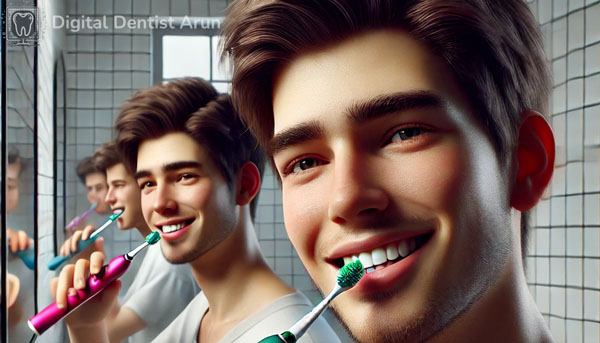
How To Take Care of Your Teeth in Different States of Life
Let’s recap some universal tips that will benefit children of any age:
1. Brush Twice a Day: Fluoride toothpaste and a soft bristle toothbrush as there choices.
2. Floss Daily: As early as we can, it is very effective to floss and this is done to remove the plaques that are in between the teeth.
3. Limit Sugary Snacks and Drinks: Describe how sugar harms teeth and also suggest alternatives to sugar that can be taken.
4. Schedule Regular Dental Visits: Annual check-ups are good because they allow any problem to be detected and handled before it gets worse.
5. Encourage Water Over Sugary Drinks: Water has the capability to remove any remaining bacteria in the mouth, and besides it is a necessity in the human body.
6. Model Good Habits: Children follow by example. Make it a point for them to notice that you are taking care of your teeth and gums.
Conclusion: Make that small change Today for a better tomorrow
Oral hygiene is a lifetime investment, which pays out in the comfort of a healthy mouth. By creating the mentioned habits early much is done to ensure the child dental health has a bright future and is confident.
These small habits implemented such as brushing, flossing and visiting dentist from time to time are key building blocks to healthy mouth and smile for ever. It’s important to address: A bright smile leads to a bright future, the positive changes they come across will impact their oral hygiene significantly. May your kids have a healthy and happy smile all through their lives!
